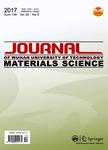Characterization and Comparison of Conducting Polyaniline Synthesized by Three Different Pathways
Characterization and Comparison of Conducting Polyaniline Synthesized by Three Different Pathways作者机构:Corrosion & Protection CenterUniversity of Science and Technology Beijing Key Laboratory for Corrosion and Protection of Ministry of Education
出 版 物:《Journal of Wuhan University of Technology(Materials Science)》 (武汉理工大学学报(材料科学英文版))
年 卷 期:2011年第26卷第6期
页 面:1068-1072页
核心收录:
学科分类:081704[工学-应用化学] 07[理学] 08[工学] 0817[工学-化学工程与技术] 070305[理学-高分子化学与物理] 080501[工学-材料物理与化学] 0805[工学-材料科学与工程(可授工学、理学学位)] 0703[理学-化学] 0702[理学-物理学]
基 金:Funded by the National Natural Science Foundation of China ( No. 50771020)
主 题:nano materials polymers polyaniline
摘 要:The conducting polyaniline (PANI) prepared by three chemical oxidative polymerization pathways including microemulsion, emulsion and aqueous solution methods were studied and compared. Their structures, morphologies and properties were characterized using FT-IR, XRD, TEM and TGA. PANI particles formed in aqueous solution have a smallest size and doping HCl enables to increase their conductivity. In contrast, PANI particles prepared by emulsion method have the highest thermal stability and conductivity and more ordered morphology. Rather different from these two methods, microemulsion approach allows forming nanocomposite PANI with tube-like nanostructure.



